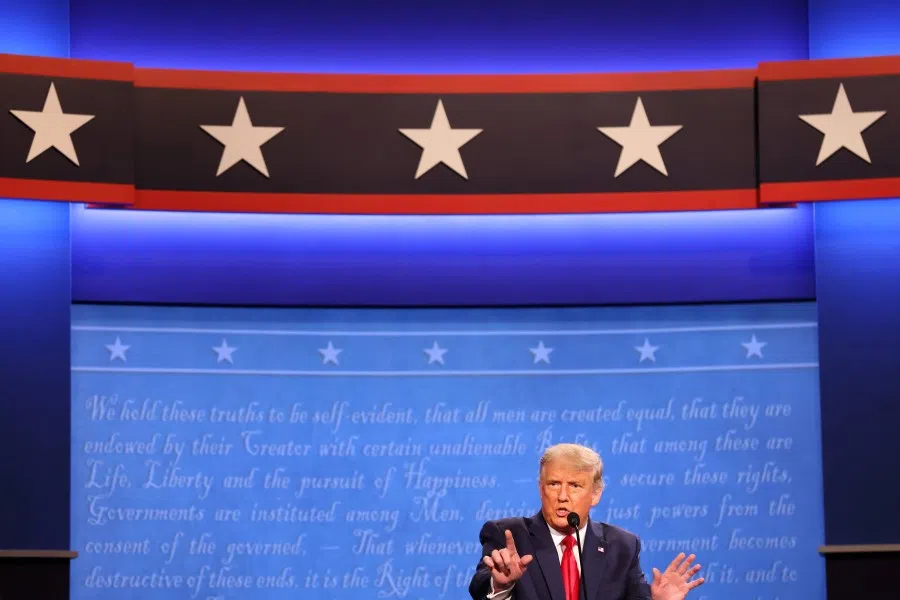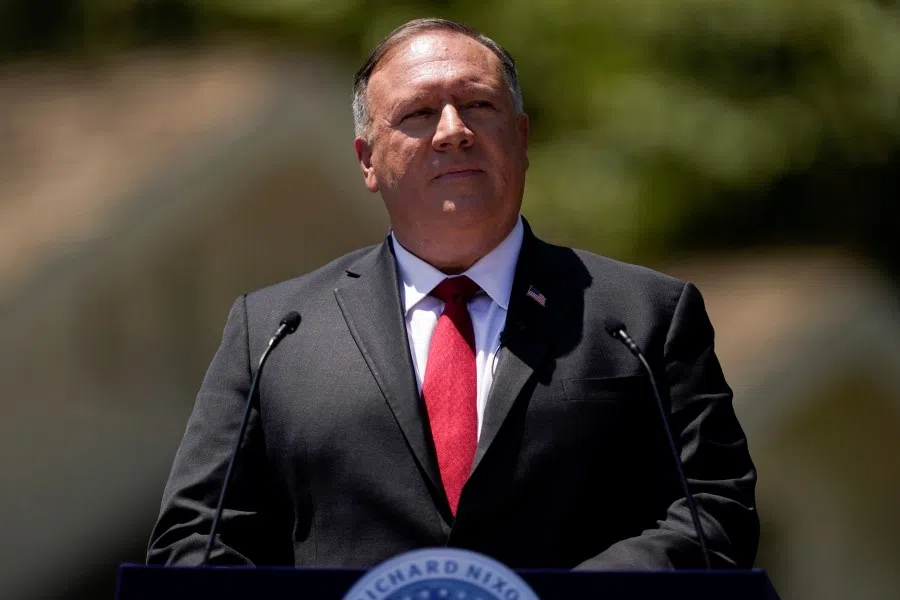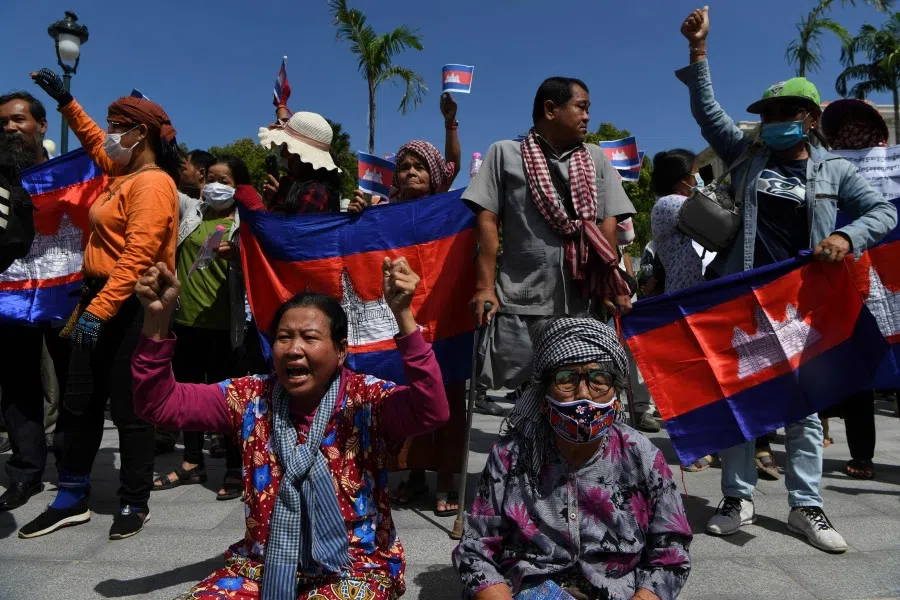Setting the rules: 'Non-negotiables' in a US-Southeast Asia relationship
Since 2016, China has presented itself as a strategic competitor to the US. In turn, the Trump administration has been accused of incoherence in its policies toward China and its approach to the Indo-Pacific has led to concerns in regional states. Whether Trump or Biden wins in November, Washington needs to recognise some non-negotiables with regards to Southeast Asia: the avoidance of presenting binary choices for regional states to make amid Sino-US rivalry; the need for a looser cooperative approach in pushing back China's assertiveness, particularly in the South China Sea; and the need to build regional connectivity networks and infrastructure.

Writing 14 months into the Trump administration in March 2018, Kurt Campbell and Ely Ratner - two senior officials who had served in the Obama Administration - argued that Washington had always had an "outsized sense" of its ability to determine China's trajectory. Nearly half a century after President Richard Nixon's historical rapprochement with China in the 1970s, however, all sides in this policy debate - free traders, integrationists and hawks - had erred.
The Trump administration's 2017 National Security Strategy, which sought to interrogate past assumptions in the US's strategy towards China was applauded. But many of the administration's policies - a narrow focus on trade deficit, the rejection of multilateral trade deals, the questioning of the value of alliances - risk making Washington's approach one that is confrontational without being competitive, while China has instead managed to be "increasingly competitive without being confrontational".
But there is value in Trump's upending of decades of conventional wisdom about China. After all, China since 2016 has presented itself as a strategic competitor to the US - in terms of its government, political ideology and economic system. The current deterioration in Sino-US relations will not recover significantly anytime soon. Going from the second half of 2020 into 2021, there are many imponderables, including the winner in the US presidential election in November 2020, that winner's China policy, and whether American attempts to "decouple" the Chinese economy will succeed. Regardless, smaller countries in Southeast Asia will have to live with these major power "elephants" which are either fighting or making love.
During his term, Trump triggered concerns among Asian countries that Washington would not shoulder the responsibility of maintaining regional and global stability, and could even stage a strategic retrenchment from the Asia-Pacific. Whether or not it is Trump or Joseph Biden, the Democratic presidential candidate, who wins the November elections, Washington's approach to the region, in particular Southeast Asia, will have three issues to focus upon: the avoidance of presenting binary choices for regional states to make amid Sino-US rivalry; the need for a looser cooperative approach in pushing back China's assertiveness, particularly in the South China Sea; and the need to build regional connectivity networks and infrastructure.
Strategic competition has now become the norm, and Washington is determined to block Chinese efforts to use market-distorting policies at overtaking the US in cutting-edge technologies, and also to prevent China from "dominating Asia and undermining the rules-based order".

US-China relations go downhill from 2016
Prior to Trump's arrival in the Oval Office in January 2017, the administration of Barack Obama had already been hardening its approach toward China. As such, the US reiterated its commitment to primacy in the Asia-Pacific, promoted the Trans-Pacific Partnership (TPP) to ensure that the US (and not China) wrote the rules of the road on trade; warned China (particularly pertaining to its build-up in the South China Sea) that the US would "fly, sail and operate wherever international law allows".
On the campaign trail in May 2016, US presidential candidate Donald Trump said that China was "raping" the US with its currency manipulation, thus damaging US business and workers. By 2017, President Trump practised a trade and tariff policy to challenge China. Unlike previous downturns in bilateral relations, the current decline under Trump has deeper and more structural causes. Strategic competition has now become the norm, and Washington is determined to block Chinese efforts to use market-distorting policies at overtaking the US in cutting-edge technologies, and also to prevent China from "dominating Asia and undermining the rules-based order".
Early on in the Trump administration, there was a consistent effort at challenging the threat posed by China. In the 2017 National Security Strategy, China and Russia were labelled "strategic competitors". In the autumn of 2018, US Vice President Mike Pence delivered a harsh speech on China, arguing that China was seeking to eject the US from the Western Pacific, control 90% of the world's advanced industries, meddle in US policies and use debt diplomacy to expand its global influence. Pence called for a "free and open Indo-Pacific" based on shared values, and a "spirit of respect built on partnership, not domination".
By 2019, the concept of a "free and open Indo-Pacific" was already gaining traction. On 1 June 2019 - the same day that Acting Defence Secretary Patrick Shanahan was due to speak at the Shangri-La Dialogue - a US Department of Defense report cast China as a "revisionist power" willing to "accept friction" in pursuit of its goals. A US State Department report on US Indo-Pacific strategy, published in November 2019, took a similar tone, arguing that China was pursuing policies that undermined "stability and prosperity in the Indo-Pacific for decades".
But it was the July 2020 speech by US Secretary of State Mike Pompeo which underscored the deepening ideological schism between China and the US. Speaking at the Richard Nixon Memorial Library, he said that the former president's policy of engagement of China had failed to induce a freer China and a China that would be less of a threat abroad. Pompeo called on the free world to "induce" the Chinese Communist Party to change direction. This confrontational approach towards China could not gain much traction in the region, in particular Southeast Asia, given the regional preference to avoid "making choices" between the US and China.
In August 2020, the US Department of Defense published a 20-year retrospective report on China's military, arguing that China's definition of a "world-class" military means that it will develop by mid-century a military equal to, or in some cases superior to the US military or that of any other great power. Interestingly, the report noted that Beijing had "likely considered" five Southeast Asia locations for military logistics facilities: Cambodia, Indonesia, Myanmar, Singapore and Thailand.

Promise and perils
Trump has been accused of incoherence and chaos in his policy-making towards China. That said, however, he has sought to address imbalances in the relationship. US academic Michael Auslin argues that there has been a fundamental shift in Washington's approach to China after four decades, in favour of reciprocity that seeks a balance between accommodation and antagonism. This, he argued, is embedded in the White House's new strategic approach to China, outlined in May 2020, which seeks to "acknowledge and respond in kind" Beijing's transactional approach with incentives and costs or "credible threats".
The US also sought to create a more level playing field in the Asia-Pacific, particularly with regards to the South China Sea. Between May 2017 and July 2020, the US conducted 24 freedom of navigation operations (FONOPs) there. In July 2020, its series of high-profile maritime exercises in the South China Sea involved two aircraft carriers operating in tandem. In April, the West Capella, a Malaysian oil exploration vessel, was shadowed by a Chinese survey vessel and a flotilla of coast guard and paramilitary vessels in the South China Sea. The US forces maintained a persistent joint presence near the Malaysian vessel for nearly a month. Pompeo's assertion in July 2020 that China's South China Sea claims were "unlawful" constituted an evolutionary step in Washington's hardening stance on the issue, and has emboldened disputant states, such as Malaysia, the Philippines and Indonesia, into using UNCLOS, as interpreted by the 2016 arbitration ruling between Beijing and Manila, in their ongoing negotiations with China on a Code of Conduct for the maritime area.
While Beijing did suffer in the trade war, it did not suffer enough for it to capitulate to Trump demands for major structural reform; it also pursued aggressive behaviour along its periphery.
While the Trump administration's approach to China is largely on-target in terms of addressing China's mercantilist position and assertive behaviour in the region, its execution has led to concerns in regional states. In addition, Trump's transactional approach towards allies, divergences between Trump and his senior officials in statements about alliances and Washington's regional presence, as well as the implementation of US policy toward China has sowed confusion.
Trump's approach to trade with China made a flawed diagnosis, which is that trade wars are easily won. Moreover, there has been an "exclusive focus" on the costs of strategic and economic engagement with China, while neglecting the benefits thereof. Tariffs levied on Chinese exports to the US have also hurt the American economy. A 2019 Bloomberg Economics report estimated that the trade war would cost the US economy US$316 billion by the end of 2020. While Beijing did suffer in the trade war, it did not suffer enough for it to capitulate to Trump demands for major structural reform; it also pursued aggressive behaviour along its periphery.
A more serious concern is the dissonance between Trump's "America First" rhetoric and its calls for stronger alliances and partnerships.

For Asian countries, American means to shape China's choices using sticks rather than carrots are excessively confrontational. A more serious concern is the dissonance between Trump's "America First" rhetoric and its calls for stronger alliances and partnerships. For example, Trump has reportedly told his advisers that the US loses US$38 billion in trade to Korea. His inclination was to respond by withdrawing US troops from the peninsula. According to a former US ambassador to Germany, Trump has been "very clear" that he wants to bring US troops home from Afghanistan, Japan, Iraq, South Korea, Japan and Germany. The rationale: American had grown "tired of paying too much" for the defence of other countries.
Capturing the zeitgeist, Singapore Prime Minister Lee Hsien Loong noted that it was "unclear" whether the US would continue to carry the burden of maintaining international peace and stability, or whether it would pursue a narrower "American First" approach at upholding its interests. Already, fears about Trump's transactional approach to alliances and a possible strategic retrenchment from the Indo-Pacific have led to mini-lateral networking processes between like-minded countries such as Australia, India, Indonesia, Japan, the Philippines, South Korea and Vietnam.
On China's part, its behaviour is tantamount to the "re-emergence of a kind of imperial hauteur", in effect a demand that its size and prominence be recognised through "subservience" to China's interests.
US options for Southeast Asia
But whoever wins in November's presidential elections, the US would be well-advised to consider the following to be "non-negotiables" if it is to maintain traction in Southeast Asia.
Avoiding binary choices
The ensuing confrontation between China and the US has left Southeast Asian countries in a difficult position. On China's part, its behaviour is tantamount to the "re-emergence of a kind of imperial hauteur", in effect a demand that its size and prominence be recognised through "subservience" to China's interests. While many regional states welcome the Trump administration's pushback against Chinese assertiveness, they have preferred to voice their support privately, lest they attract Beijing's retaliation.
Southeast Asian states do want to avoid "making choices" between the two major powers, but the US' allies and partners in Asia worry that the US is less capable and less committed to providing them with the same security guarantees as had been the case in the past. Such concerns might be ameliorated if Trump is voted out in the November elections; still, doubts about the endurability of US power and presence in the region will continue, given Washington's "diplomatic attention span" and its military capabilities. No matter whether it be Trump or Biden who wins the elections, American interests would appear to be better served if the US avoids forcing Southeast Asian countries to "choose" between China and US, and instead offers them choices (and reasons) to tack on to American initiatives.
Going easy on ideological arguments
The American approach of using democracy and ideology to confront China has proven ill-advised. For one thing, Chinese citizens' level of satisfaction with the CCP has been going up between 2003 and 2016. Second, Southeast Asian states are traditionally leery of the issue of democracy, particularly in light of the "illiberal turn" taken in some ASEAN member states. Southeast Asians with longer memories remember that the American-backed security order was a "bloody business", involving American wars in Indonesia, its backing of communist purges in Indonesia in the mid-1960s and US tolerance for a string of anti-communist autocrats in Indonesia, the Philippines and Thailand, not to mention the Vietnam War. The US would be wise if it capitalises on Southeast Asian countries' predilection for Washington by accepting the region's relatively "agnostic approach" to the great powers.
China and the US can find a way to cooperate on issues, such as China helping to build infrastructure in the US, climate change and nuclear proliferation.

Despite their ongoing differences in trade, technology and human rights (to name but a few), China and the US should still be able to find areas of cooperation. Such a move would be a net positive for the region. The US should seek to accommodate Chinese aspirations within the existing system of rules and norms, while China collaborates with the US and other countries to revise arrangements for the international order. China and the US can find a way to cooperate on issues, such as China helping to build infrastructure in the US, climate change and nuclear proliferation.
A looser cooperative approach
A looser more cooperative approach as advocated by Mark Esper, the US Defence Secretary, should reap dividends. Speaking at a seminar in July 2020, Esper called for a network of regional countries to consult diplomatically and "pursue things" to defend the rules-based order in the region. This is similar to the "principled security network" proposed by his Obama-era predecessor Ash Carter in 2016, which advocates using the complex web of America's bilateral and multilateral relationships to advance shared values and burden-sharing. A natural analogue of Esper's network concept is the emerging Indo-Pacific strategy, which has been endorsed by Australia, India, Japan and the US. The concept seeks to promote the principles of adherence to the rule of law, freedom of navigation and overflight and no recourse to the use of force, and has already gained some purchase with ASEAN. But the grouping has been careful not to use any formulation that targets China, directly or indirectly.
A natural and logical application of Esper's network concept is in the disputed South China Sea. In line with Washington's appeal for the upholding of the rules-based order in the region, ASEAN member states have raised the aegis of international law to reject China's nine-dash line claim in the South China Sea. While they have not cast their rejection of China's claims as being congruent with Esper's network formulation, their actions nevertheless uphold the rules-based order. Granted, the use of lawfare will do little to change the contours of the South China Sea dispute, but the concerted show of effort could give China some ground for caution if it considers steps which could constitute crossing a "red line", for example, turning Scarborough Shoal into an artificial island or establishing an Air Defence Identification Zone in the South China Sea.

Further afield, external powers have sought to uphold the rules-based order, particularly in the South China Sea. India is reportedly considering inviting Australia to the Malabar series of maritime exercises (which currently involve the US, Indian and Japanese navies). Canberra has also rejected China's claims to the South China Sea. Japan's recent efforts have centred on Indo-Pacific naval deployments involving its Izumo-class carriers, and exercises with like-minded navies. In April to June 2019, the JS Izumo, participated in exercises and interactions with Brunei, Malaysia, Singapore, the Philippines and Vietnam. The highlight of the JS Izumo's 2019 deployment involved a four-nation naval exercise, with six ships from Japan, India, the Philippines and the United States, in the South China Sea. The exercise has been interpreted as an overt signal to China.
Thus far, the US has not offered any alternative to Huawei, which has offered these countries an efficient and cost-effective option.
Need to work on infrastructure
China's Belt and Road Initiative, which has been criticised by the US as predatory "debt trap" economics, is addressing a real need in the region in terms of infrastructure. Together with Japan and Australia, the US can use the financing of infrastructure as a bid to uphold the concept of a free and open Indo-Pacific. Between 2008 and 2016, China overtook Japan as the region's biggest bilateral financier of infrastructure projects, with US$42 billion versus US$37 billion; Australia and the US invest far less in infrastructure, namely US$1.8 billion and US$1.1 billion respectively. To compete with China's scale of financing, the trilateral partners can conceivably raise their allocations to official development assistance, from 0.2% of Gross National Income (GNI), to the OECD average of 0.3% of GNI.
Other options that the US can lay before Southeast Asian countries is a renegotiation of the TPP (or its successor the 11-nation Comprehensive and Progressive Agreement for Trans-Pacific Partnership), which Trump withdrew the US from in 2017. Biden has agreed to renegotiate the pact if he is elected in November. And even as the US seeks to "decouple" the US economy from the Chinese economy, particularly in areas of technology and networks, it should still continue to offer options to Southeast Asian countries such as Malaysia, Thailand and the Philippines -which are adopting Huawei technologies for their 5G networks. Thus far, the US has not offered any alternative to Huawei, which has offered these countries an efficient and cost-effective option. The American offer to finance the replacement of Huawei infrastructure in developing countries such as the Philippines and Thailand is a good start.
Maintaining traction in Southeast Asia
Biden's approach to China will not differ much from Trump's, given the bipartisan approach in Washington towards challenging China. While Biden may confront China on issues such as trade, technology, cybertheft and human rights, the relationship under Biden will not be a rush into a new cold war. What Biden may bring to the table is the ability to leverage on the power and "behaviour of American allies and partners" to prosecute American goals and interests. Some see this as reason enough for China to prefer a Trump victory in the November elections. Whether or not it is Biden or Trump who wins, Washington should be able to maintain traction in Southeast Asia by laying options on the table for regional countries to tack on to.
This article was first published as ISEAS Perspective 2020/122 "Sino-US Rivalry: Non-Negotiables for US Approaches to Southeast Asia" by William Choong.
Related: Trump vs Biden: Who makes a better choice for Southeast Asia | Biden or Trump? Southeast Asia's stakes in the US election | Unfavourable views: Southeast Asia's perceptions of China and the US worsen amid Covid-19 | China's Southeast Asian charm offensive: Is it working? | How a Biden presidency can win back lost American influence in Southeast Asia

![[Big read] Paying for pleasure: Chinese women indulge in handsome male hosts](https://cassette.sphdigital.com.sg/image/thinkchina/c2cf352c4d2ed7e9531e3525a2bd965a52dc4e85ccc026bc16515baab02389ab)


![[Big read] How UOB’s Wee Ee Cheong masters the long game](https://cassette.sphdigital.com.sg/image/thinkchina/1da0b19a41e4358790304b9f3e83f9596de84096a490ca05b36f58134ae9e8f1)
